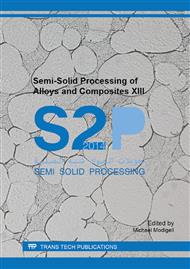p.381
p.389
p.397
p.405
p.412
p.418
p.426
p.431
p.436
Effects of Inclined Plate Angle and Length on Semi-Solid Microstructure of Martensitic Stainless Steel
Abstract:
An experimental equipment with inclined plate cooling and shearing had been developed to prepare semi-solid 9Cr18 martensitic stainless steel slurry. The effects of inclined plate angel and length on microstructures refinement and spheroidization in semi-solid 9Cr18 alloy was investigated. The results show that when the molten alloy is flowing along the plate surface, the microstructure of the alloy involves from coarse dendrite to fine spherical grains, the sloping plate can provide sufficiently the undercooling for nucleation and lay a foundation for heterogeneous nucleation to form lots of nuclei of crystal internally and on the sloping plate surface, thus causing the melt to nucleate eruptively. Sloping plate angle and sloping plate length can affect the shear strength and shear time of the flow alloy on the sloping plate and thus influence alloy microstructure. Fine spherical grain in the semi-solid 9Cr18 slurry can be obtained at α=45°and L=600mm, the major grain equivalent diameters are less than 55μm and more than 40% of the grain shape factor is in 0.75, exhibiting better grain fine degree and roundness. Using energy dispersive spectrometer (EDS) to investigate the liquid and solid phase in the 9Cr18 semi-solid slurry, iron content is lower and carbon and chromium content is higher in the liquid phase than in the solid phase which makes it possible to prepare the FGM (functional gradient material) with a high wear resistance in the surface and a good strength and toughness in the center.
Info:
Periodical:
Pages:
412-417
Citation:
Online since:
September 2014
Authors:
Keywords:
Price:
Сopyright:
© 2015 Trans Tech Publications Ltd. All Rights Reserved
Share:
Citation:


